Related Research Articles
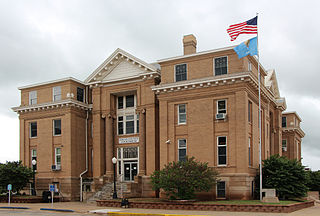
Logan County is a county located in the U.S. state of Oklahoma. As of the 2010 census, the population was 41,848. Its county seat is Guthrie.
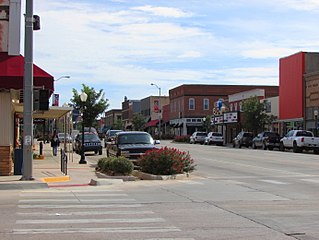
Kingfisher is a city in and the county seat of Kingfisher County, Oklahoma,. The population was 4,903 at the time of the 2020 census. It is the former home and namesake of Kingfisher College. According to the Encyclopedia of Oklahoma History and Culture, Kingfisher is now primarily a bedroom community for people employed in Enid and Oklahoma City.

Cashion is a town in Kingfisher and Logan counties in the U.S. state of Oklahoma. The Logan County portion of Cashion is part of the Oklahoma City Metropolitan Statistical Area. The town population was 802 at the 2010 census, up from 643 in 2000.

BNSF Railway is one of the largest freight railroads in North America. One of seven North American Class I railroads, BNSF has 35,000 employees, 32,500 miles (52,300 km) of track in 28 states, and nearly 8,000 locomotives. It has three transcontinental routes that provide rail connections between the western and eastern United States. BNSF trains traveled over 169 million miles in 2010, more than any other North American railroad.
The Fort Smith and Western Railway was a railroad that operated in the states of Arkansas and Oklahoma.
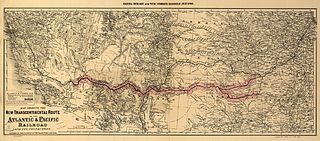
The Atlantic and Pacific Railroad was a U.S. railroad that owned or operated two disjointed segments, one connecting St. Louis, Missouri with Tulsa, Oklahoma, and the other connecting Albuquerque, New Mexico with Needles in Southern California. It was incorporated by the U.S. Congress in 1866 as a transcontinental railroad connecting Springfield, Missouri and Van Buren, Arkansas with California. The central portion was never constructed, and the two halves later became parts of the St. Louis-San Francisco Railway and Atchison, Topeka and Santa Fe Railway systems, now both merged into the BNSF Railway.

The Toledo, Peoria and Western Railway is a short line railroad that operates 247 miles (398 km) of track from Mapleton, Illinois, through Peoria across Illinois to Logansport, Indiana. TP&W has trackage rights between Galesburg, Illinois, and Peoria, between Logansport and Kokomo, Indiana, and between Reynolds, Indiana, and Lafayette, Indiana. TPW has connections with UP, BNSF, NS, CSXT, CN, CP, CERA, CIM, KBSR and T&P. The railroad is now owned by Genesee & Wyoming Inc. The railroad's traffic comes largely from agricultural products, including both raw and processed grain products, as well as chemicals and completed tractors. The TPW hauled around 26,000 carloads in 2008.
The Oklahoma Central Railroad, (OCR) earlier the Oklahoma Central Railway, was a railroad operating in the U.S. state of Oklahoma from 1907 to 1917. It was formed by Dorset Carter of Purcell, Indian Territory, and other business interests. The corporation started life on September 20, 1904 as the Canadian Valley and Western Railway Company. It changed its name to the Oklahoma Central Railway Company on September 27, 1905. Construction was started in Lehigh, Oklahoma, in 1906 and was completed to Chickasha, Oklahoma, in 1908. The route was primarily constructed to transport coal from the mines at Lehigh to Purcell in order to service steam locomotives on the Santa Fe, which maintained a division point at that location.

The California Southern Railroad was a subsidiary railroad of the Atchison, Topeka and Santa Fe Railway in Southern California. It was organized July 10, 1880, and chartered on October 23, 1880, to build a rail connection between what has become the city of Barstow and San Diego, California.

The Panhandle and Santa Fe Railway (P&SF) is a now-defunct railroad company that was a subsidiary of the Atchison, Topeka and Santa Fe Railway (AT&SF), operating primarily in the Texas Panhandle.
The Denver, Enid and Gulf Railroad (DE&G) was built as a short line railroad operating in Kansas, and Oklahoma. Incorporated in Oklahoma as the Denver, Enid and Gulf Railroad Company, March 31, 1902, by the five Frantz Brothers.
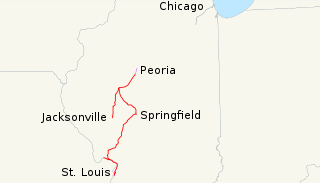
The Chicago, Peoria and St. Louis Railroad (CP&StL) was a railroad in the U.S. state of Illinois that operated a main line between Pekin and Madison via Springfield. Its property was sold at foreclosure to several new companies in the 1920s; the portion north of Springfield has since become the Illinois and Midland Railroad, while the remainder has been abandoned, except for a portion near St. Louis that is now owned by the Norfolk Southern Railway.
The following is a brief history of the North American rail system, mainly through major changes to Class I railroads, the largest class by operating revenue.
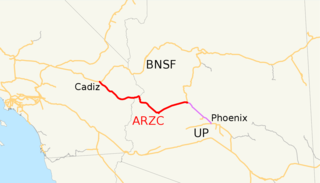
The Arizona and California Railroad is a class III short line railroad that was a subdivision of the Atchison, Topeka and Santa Fe Railway (ATSF). The ARZC began operations on May 9, 1991, when David Parkinson of the ParkSierra RailGroup purchased the line from the Santa Fe Railway. ParkSierra Railgroup was purchased in January 2002 by shortline railroad holding company RailAmerica. The Genesee & Wyoming shortline railroad holding company purchased RailAmerica in December 2012. ARZC's main commodities are petroleum gas, steel, and lumber; the railroad hauls around 12,000 carloads per year.

The Fort Worth and Rio Grande Railway, chartered under the laws of Texas on June 1, 1885, was part of a plan conceived by Buckley Burton Paddock and other Fort Worth civic leaders to create a transcontinental route linking New York, Fort Worth, and the Pacific port of Topolobampo, which they believed would stimulate the growth and development of southwest Texas in general, and the economy of Fort Worth in particular.
The Clinton and Oklahoma Western Railroad was a railway in southwestern Oklahoma and the Texas Panhandle, with a mainline eventually running from Clinton, Oklahoma to Pampa, Texas, about 139 miles. The predecessor company was incorporated in 1908, and the railroad was merged out of existence in 1948.

The Illinois Northern Railroad was an industrial switching railroad serving Chicago's southwest side. From their yard at 26th St. and Western Ave. the line went southwest to the Santa Fe Railway's Corwith Yard, connecting with most major area railroads and serving on-line customers on the way. They also leased and switched track east of their yard. Incorporated in 1901, it was merged into the Santa Fe Railway in 1975.
The Eastern Oklahoma Railway was incorporated under the laws of Oklahoma Territory on July 24, 1899. The railroad constructed much of its own track. This included Guthrie junction to Cushing junction, 47.9 miles, in the 1900-1902 timeframe; Ripley to Esau Junction, 40.4 miles, also in the 1900-1902 timeframe; Newkirk to Pauls Valley, 182.5 miles, in the 1900-1904 timeframe; and, Davis to Sulphur, 9.3 miles, in 1906.
The genesis of the Guthrie and Western Railway (G&WR) may be said to have occurred January 9, 1900, at a public meeting in the city of Guthrie, Oklahoma. At least one recollection of the evening involved the crowd being told that, while the town was already served by the Atchison, Topeka and Santa Fe Railway (AT&SF), it was not served by the Chicago, Rock Island and Pacific Railroad ; and, if the town could raise $15,000, the Rock Island would-- perhaps under another name-- build a line from a connection with its track near Kingfisher into the city of Guthrie. What actually happened was that funding was raised for the G&WR, an affiliate of the AT&SF. Incorporated in Oklahoma Territory on that same date, the railroad during 1900 built from a point on the main line of the AT&SF at or between the stations of Seward and Guthrie, to the Rock Island’s line at or near Kingfisher, 10.6 miles.
The Oklahoma, New Mexico and Pacific Railway, known colloquially as the “Ringling Railroad,” ran from Ardmore, Oklahoma to Ringling, Oklahoma, with a branch to Healdton, Oklahoma. It was started in 1913, and was sold to an Atchison, Topeka and Santa Fe Railway (AT&SF) affiliate in 1926.
References
- 1 2 3 "The Guthrie and Kingfisher Railway Company". Railroads of Oklahoma, June 6, 1870 to April 1, 1978 (accessed on Oklahoma Digital Prairie), p.40-43. Retrieved February 17, 2023.
- 1 2 3 4 "Cashion". Oklahoma Historical Society. Retrieved February 17, 2023.
- 1 2 3 "Rock Island Lines, the First Century". William Edward Hayes, H. Wolff Book Manufacturing Co., 1953, p. 150 (accessed on Illinois Library). Retrieved February 17, 2023.
- ↑ "The Guthrie Plan, 2002, p.2". City of Guthrie. Retrieved February 18, 2023.
- ↑ "Cashion". Google Maps. Retrieved February 17, 2023.
- 1 2 3 Morris, John Wesley (1977). Downs. ISBN 9780806114200 . Retrieved February 17, 2023.
- ↑ "The Guthrie and Western Railway Company". Railroads of Oklahoma, June 6, 1870 to April 1, 1978 (accessed on Oklahoma Digital Prairie), p.29-39. Retrieved February 17, 2023.